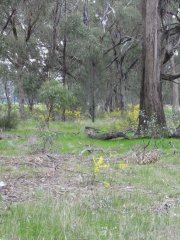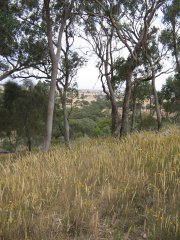
Grey Box and Buloke Grassy Woodlands are open woodlands of the Riverina and Murray Darling Depression Bioregions. They are typically found on well drained soils, in areas with < 600 mm p.a. of rainfall and are rarely flooded for long periods.
The canopy typically consists of Grey Box (dominant species) and Buloke, however other trees such as White Box and White-Cypress Pine may occur. The typical density of Buloke in the Goulburn Broken is 1-2 mature trees per hectare. Buloke may not always be present particularly at the patch scale, but will occur in the neighbourhood.
The understorey is open and grassy, typically consisting of native grasses and herbs such as lillies, daisies and saltbushes (chenopods). Shrubs are sparse and typically include Wattles, Sweet Bursaria and Cassinia

